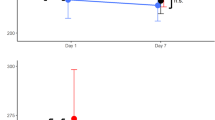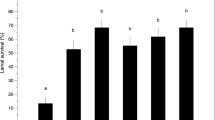Abstract
The Antarctic midge, Belgica antarctica, is the only insect that is endemic to the Antarctic Peninsula and its offshore islands. The final (fourth) instar larvae exhibit high inherent thermal tolerance to short-term temperature exposure, and many studies have focused on the underlying molecular physiological mechanisms of their thermal tolerance. In contrast, the thermal strategy of embryos has received little attention, and the effects of long-term thermal exposure on newly hatched larvae have not been investigated. The present study reports that the average supercooling point of egg masses was − 4.7 °C and that the first instar larvae successfully emerged from the frozen egg masses. The embryos also demonstrated significant heat tolerance and the first instar larvae successfully emerged from the egg masses kept at temperatures ranging from 0 to 15 °C. These indicate that embryos have sufficient tolerance to cold and heat during Antarctic summer. Interestingly, the first instar larvae developed into fourth instar larvae at 4 °C, but not at other temperatures. Early instar larvae have a narrow temperature window for their development, suggesting that they are susceptible to environmental changes.


Similar content being viewed by others
Data availability
All the data obtained during this study are included in this article and its online resource.
References
Allegrucci G, Carchini G, Todisco V, Convey P, Sbordoni V (2012) A molecular phylogeny of antarctic chironomidae and its implications for biogeographical history. Polar Biol 29:320–326. https://doi.org/10.1007/s00300-005-0056-7
Bartlett JC, Convey P, Hayward SAL (2019) Life cycle and phenology of an Antarctic invader: the flightless chironomid midge, Eretmoptera murphyi. Polar Biol 42:115–130. https://doi.org/10.1007/s00300-018-2403-5
Baust JG, Edwards JS (1979) Mechanisms of freezing tolerance in an Antarctic midge, Belgica antarctica. Physiol Entomol 4:1–5. https://doi.org/10.1111/j.1365-3032.1979.tb00171.x
Baust JG, Lee RE (1987) Multiple stress tolerance in an Antarctic terrestrial arthropod: Belgica antarctica. Cryobiology 24:140–147. https://doi.org/10.1016/0011-2240(87)90016-2
Block W, Burn AJ, Richard KJ (1984) An insect introduction to the maritime Antarctic. Biol J Linn Soc 23:33–39. https://doi.org/10.1111/j.1095-8312.1984.tb00804.x
Carrillo MA, Kaliyan N, Cannon CA, Morey RV, Wilcke WF (2004) A simple method to adjust cooling rates for supercooling point determination. CryoLetters 25:155–160
Colinet H, Sinclair BJ, Vernon P, Renault D (2015) Insects in fluctuating thermal environments. Annu Rev Entomol 60:123–140. https://doi.org/10.1146/annurev-ento-010814-021017
Convey P, Block W (1996) Antarctic Diptera: ecology, physiology and distribution. Eur J Entomol 93:1–13
Damos P, Savopoulou-Soultani M (2012) Temperature-driven models for insect development and vital thermal requirements. Psyche. https://doi.org/10.1155/2012/123405
Devlin JJ, Unfried L, Lecheta MC, McCabe EA, Gantz JD, Kawarasaki Y, Elnitsky MA, Hotaling S, Michel AP, Convey P, Hayward SAL, Teets NM (2022) Simulated winter warming negatively impacts survival of Antarctica’s only endemic insect. Funct Ecol 36:1949–1960. https://doi.org/10.1111/1365-2435.14089
Edwards JS, Baust J (1981) Sex ratio and adult behaviour of the Antarctic midge Belgica antarctica (Diptera, Chironomidae). Ecol Entomol 6:239–243. https://doi.org/10.1111/j.1365-2311.1981.tb00611.x
Elnitsky MA, Hayward SAL, Rinehart JP, Denlinger DL, Lee RE (2008) Cryoprotective dehydration and the resistance to inoculative freezing in the Antarctic midge, Belgica antarctica. J Exp Biol 211:524–530. https://doi.org/10.1242/jeb.011874
Hayward SAL, Rinehart JP, Sandro LH, Lee RE, Denlinger DL (2007) Slow dehydration promotes desiccation and freeze tolerance in the Antarctic midge Belgica antarctica. J Exp Biol 210:836–844. https://doi.org/10.1242/jeb.02714
Kawarasaki Y, Teets NM, Denlinger DL, Lee RE (2014) Alternative overwintering strategies in an Antarctic midge: freezing vs. cryoprotective dehydration. Funct Ecol 28:933–943. https://doi.org/10.1111/1365-2435.12229
Kawarasaki Y, Teets NM, Philip BN, Potts LS, Gantz JD, Denlinger DL, Lee RE (2019) Characterization of drought-induced rapid cold-hardening in the Antarctic midge, Belgica antarctica. Polar Biol 42:1147–1156. https://doi.org/10.1007/s00300-019-02503-6
Lee RE, Denlinger DL (2015) Stress tolerance in a polyextremophile: the southernmost insect. Can J Zool 93:679–686. https://doi.org/10.1139/cjz-2014-0147
Lee RE, Elnitsky MA, Rinehart JP, Hayward SAL, Sandro LH, Denlinger DL (2006) Rapid cold-hardening increases the freezing tolerance of the Antarctic midge Belgica antarctica. J Exp Biol 209:399–406. https://doi.org/10.1242/jeb.02001
Rinehart JP, Hayward SAL, Elnitsky MA, Sandro LH, Lee RE, Denlinger DL (2006) Continuous up-regulation of heat shock proteins in larvae, but not adults, of a polar insect. Proc Natl Acad Sci USA 103:14223–14227. https://doi.org/10.1073/pnas.0606840103
Sinclair BJ (1999) Insect cold tolerance: How many kinds of frozen? Eur J Entomol 96:157–164
Spacht DE, Gantz JD, Devlin JJ, McCabe EA, Lee RE, Denlinger DL, Teets NM (2021) Fine-scale variation in microhabitat conditions influences physiology and metabolism in an Antarctic insect. Physiol Ecol 197:373–385. https://doi.org/10.1007/s00442-021-05035-1
Sugg P, Edwards JS, Baust J (1983) Phenology and life history of Belgica antarctica, an Antarctic midge (Diptera: Chironomidae). Ecol Entomol 8:105–113. https://doi.org/10.1111/j.1365-2311.1983.tb00487.x
Teets NM, Kawarasaki Y, Lee RE, Denlinger DL (2011) Survival and energetic costs of repeated cold exposure in the Antarctic midge, Belgica antarctica: a comparison between frozen and supercooled larvae. J Exp Biol 214:806–814. https://doi.org/10.1242/jeb.051912
Teets NM, Peyton JT, Colinet H, Renault D, Kelley JL, Kawarasaki Y, Lee RE, Denlinger DL (2012) Gene expression changes governing extreme dehydration tolerance in an Antarctic insect. Proc Natl Acad Sci USA 109:20744–20749. https://doi.org/10.1073/pnas.1218661109
Usher MB, Edwards M (1984) A dipteran from south of the Antarctic Circle: Belgica antarctica (Chironomidae), with a description of its larva. Biol J Linn Soc 22:19–31. https://doi.org/10.1111/j.1095-8312.1984.tb00803.x
Wirth WW, Gressitt JL (1967) Diptera: chironomidae (midges). Antarct Res Ser Natl Res Counc 10:197–203. https://doi.org/10.1029/AR010p0197
Yi SX, Benoit JB, Elnitsky MA, Kaufmann N, Brodsky JL, Zeidel ML, Denlinger DL, Lee RE (2011) Function and immune-localization of aquaporin in the Antarctic midge Belgica antarctica. J Insect Physiol 57:1096–1105. https://doi.org/10.1016/j.jinsphys.2011.02.006
Yoshida M, Lee RE, Denlinger DL, Goto SG (2021) Expression of aquaporin in response to distinct dehydration stresses that confer stress tolerance in the Antarctic midge Belgica antarctica. Comp Biochem Physiol A 256:110928. https://doi.org/10.1016/j.cbpa.2021.110928
Acknowledgements
This work was supported by the JST SPRING (Grant No. JPMJSP2139). We are grateful to Drs. D. L. Denlinger and R. E. Lee for providing insects for us and advising us on this study. We thank Dr. K. Soga for allowing us to use the illuminometer. We also thank Editage (http://www.editage.co.jp) for English editing.
Author information
Authors and Affiliations
Contributions
MY and SGG conceived and designed the study. MY conducted the experiments. MY analyzed data. MY and SGG wrote the manuscript. Both authors have read and approved the manuscript.
Corresponding author
Ethics declarations
Conflict of interest
We declare we have no conflict of interest.
Additional information
Publisher's Note
Springer Nature remains neutral with regard to jurisdictional claims in published maps and institutional affiliations.
Supplementary Information
Below is the link to the electronic supplementary material.
Rights and permissions
Springer Nature or its licensor (e.g. a society or other partner) holds exclusive rights to this article under a publishing agreement with the author(s) or other rightsholder(s); author self-archiving of the accepted manuscript version of this article is solely governed by the terms of such publishing agreement and applicable law.
About this article
Cite this article
Yoshida, M., Goto, S.G. Thermal responses of the embryos and early instar larvae of the Antarctic midge Belgica antarctica (Insecta: Diptera). Polar Biol 46, 539–544 (2023). https://doi.org/10.1007/s00300-023-03142-8
Received:
Revised:
Accepted:
Published:
Issue Date:
DOI: https://doi.org/10.1007/s00300-023-03142-8




